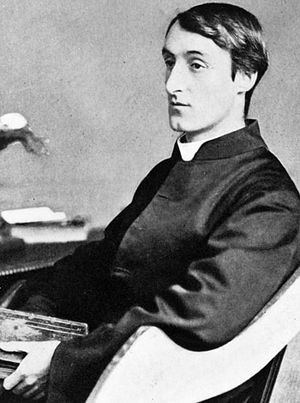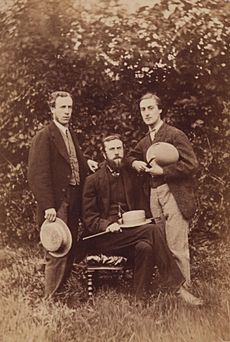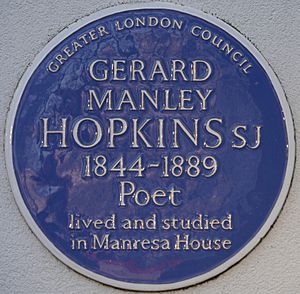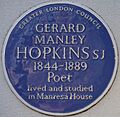Gerard Manley Hopkins facts for kids
Quick facts for kids The Reverend Gerard Manley Hopkins SJ |
|
|---|---|
 |
|
| Church | Latin Church |
| Orders | |
| Ordination | September 1877 |
| Personal details | |
| Born | 28 July 1844 Stratford, Essex, England |
| Died | 8 June 1889 (aged 44) Dublin, Ireland |
| Buried | Glasnevin Cemetery, Dublin, Ireland |
| Nationality | British |
| Denomination | Roman Catholic |
| Occupation |
|
| Education | Highgate School |
| Alma mater | Heythrop College, London Balliol College, Oxford |
Gerard Manley Hopkins (born 28 July 1844 – died 8 June 1889) was an English poet and Jesuit priest. He became famous after his death and is now seen as one of the most important Victorian poets. Hopkins was very creative with how he wrote poems. He used a special rhythm called sprung rhythm. He also praised God by using strong pictures and descriptions of nature in his poems.
His friend, Robert Bridges, started to publish some of Hopkins's poems after he died. By 1930, people realized how special his work was. His poems later influenced many famous 20th-century poets. These included T. S. Eliot, Dylan Thomas, and W. H. Auden.
Contents
Early Life and Family
Gerard Manley Hopkins was born in Stratford, England. He was the oldest of nine children born to Manley and Catherine Hopkins. His father was a businessman and also wrote poetry. His mother loved music and reading. Both of his parents were very religious.
Gerard's aunt taught him to sketch. He loved art and wanted to be a painter when he was young. He continued to draw throughout his life. He was inspired by artists like John Ruskin. His early art training helped him later as a poet. His brothers and sisters were also interested in language, religion, and art.
In 1852, his family moved to Hampstead. When Gerard was ten, he went to Highgate School (1854–1863). There, he wrote his earliest known poem, "The Escorial." He also tried to practice self-discipline. For example, he once tried not to drink water for a week. He also tried not to eat salt for a week. One of his teachers, Richard Watson Dixon, became a good friend.
Oxford and Becoming a Priest
Hopkins studied old languages and history at Balliol College, Oxford (1863–1867). He became good friends with Robert Bridges there. This friendship was very important for his poetry. Hopkins was also impressed by the poet Christina Rossetti.
In 1865, Hopkins decided to focus his life and work on God. He even wrote a poem called The Habit of Perfection. In 1866, he decided to become a Roman Catholic. He went to Birmingham to meet John Henry Newman, a famous Catholic leader. Newman welcomed him into the Catholic Church in October 1866.
This decision caused some distance between Hopkins and his family. After college, he taught in Birmingham. In 1868, he decided to become a Jesuit priest. He even burned most of his poems. He felt that his love for poetry was stopping him from fully dedicating himself to religion.
In 1872, he read the ideas of Duns Scotus, a medieval thinker. This helped him see that poetry and religion did not have to be separate. He started writing a detailed journal again. He also wrote music and sketched.
In 1874, Hopkins returned to teach. While studying to be a priest in Wales, his leader asked him to write a poem. This poem was about a German ship that sank in a storm. So, in 1875, he started writing poetry again. He wrote "The Wreck of the Deutschland" about the disaster. This poem showed his religious feelings and his new, unusual rhythms. The poem was accepted but not printed. This made him unsure about his poetry. Most of his poems were not published until after he died.
Hopkins chose a strict life as a Jesuit. He sometimes felt sad. He failed his final theology exam, which meant he would not advance much in the Jesuit order. In 1877, he wrote famous sonnets like God's Grandeur and "The Starlight Night." He also finished "The Windhover" before becoming a priest.
After becoming a priest in October 1877, his work became less stable. He taught at Mount St Mary's College and later worked as a curate in London, Oxford, Manchester, Liverpool, and Glasgow. In Oxford, he helped start The Newman Society for Catholic students.
In 1884, he became a professor of Greek and Latin at University College Dublin. He was English, and he disagreed with the Irish politics of the time. He was also small and shy. These things made it hard for him to be an effective teacher. His loneliness in Ireland made him feel even sadder. This sadness showed up in his poems, which are sometimes called "terrible sonnets." They were not terrible because they were bad poems, but because they showed his deep sadness.
Later Years
Several things made Hopkins feel sad and limited his poetry in his last five years. He had a lot of work. He did not like living in Dublin, away from his friends and England. His health was not good, and his eyesight got worse. He felt trapped and down.
As a very religious Jesuit, he faced a problem with his art. He wanted to be humble, so he decided not to publish his poems. But he also knew that a true poet needs an audience. This struggle between his religious duties and his poetry made him feel like he had failed at both.
After several years of poor health, Hopkins died of typhoid fever in 1889. He was 44 years old. He was buried in Glasnevin Cemetery in Dublin. Some people think he suffered from bipolar disorder or depression. However, his last words were, "I am so happy, I am so happy. I loved my life."
Poetry
Poems of Sadness
Towards the end of his life, Hopkins had long periods of sadness. His "terrible sonnets" deal with religious doubt. He called them "the thin gleanings of a long weary while."
"Thou Art Indeed Just, Lord" (1889) asks why bad people sometimes do well. It shows the frustration of a faithful person who feels forgotten. Hopkins uses dry roots as a picture for despair.
In "I wake and feel the fell of dark, not day," he describes lying awake before dawn. He compares his prayers to "dead letters sent To dearest him that lives alas! away." This shows his feeling of being far from God. "No Worst, There is None" and "Carrion Comfort" are also part of these sad poems.
Sprung Rhythm
"Pied Beauty"
Glory be to God for dappled things—
For skies of couple-colour as a brinded cow;
For rose-moles all in stipple upon trout that swim;
Fresh-firecoal chestnut-falls; finches' wings;
Landscape plotted and pieced—fold, fallow, and plough;
And áll trádes, their gear and tackle and trim.
All things counter, original, spare, strange;
Whatever is fickle, freckled (who knows how?)
With swift, slow; sweet, sour; adazzle, dim;
He fathers-forth whose beauty is past change:
Praise him.
Hopkins is historically important because he changed how poetry was written. Before him, most English poetry followed a strict rhythm. This rhythm used repeating groups of two or three syllables. Hopkins called this "running rhythm."
Hopkins was interested in an older English rhythm, like in the poem Beowulf. He called his own rhythm sprung rhythm. In sprung rhythm, the groups of syllables can have different numbers of syllables (usually one to four). The stress always falls on the first syllable. Hopkins felt this rhythm allowed him to be more creative. His work is seen as an early example of free verse, which is poetry without a regular rhythm.
How He Used Language
The language in Hopkins's poems is often amazing. His pictures can be simple, like in Heaven-Haven. There, he compares a nun entering a convent to a ship entering a safe harbor. His language can also be complex, like in As Kingfishers Catch Fire. In this poem, he uses many images to show how everything expresses its own specialness.
Hopkins liked pure English. He learned Old English, which greatly influenced his writing. He used many old or dialect words. He also made up new words. For example, twindles seems to mean a mix of twines and dwindles. He often created compound adjectives, like dapple-dawn-drawn falcon. This way of using words made his images stronger.
He also used a lot of alliteration (repeating sounds at the start of words) and assonance (repeating vowel sounds). He used onomatopoeia (words that sound like what they mean) and rhyme. This makes his poems sound rich, especially when read aloud.
As kingfishers catch fire, dragonflies draw flame;
As tumbled over rim in roundy wells
Stones ring; like each tucked string tells, each hung bell's
Bow swung finds tongue to fling out broad its name;
Hopkins was influenced by the Welsh language, which he learned in Wales. Welsh poetry forms, especially cynghanedd, focus on repeating sounds. This fit his style and became a key part of his work.
An important idea in his work is inscape. This means the special, unique quality that makes each thing what it is. Instress is the energy that holds this unique quality together. It is also how we notice it. For example, when we admire the delicate petals of a tulip, we are "instressing" its "inscape."
The Windhover is one of Hopkins's most famous poems. He thought it was his best. It tries to show not just any bird, but one specific moment of a bird and how it relates to the wind.
I caught this morning morning's minion, king-
dom of daylight's dauphin, dapple-dawn-drawn Falcon, in his riding
Of the rolling level underneath him steady air, and striding
High there, how he rung upon the rein of a wimpling wing
In his ecstasy! then off, off forth on swing,
As a skate's heel sweeps smooth on a bow-bend: the hurl and gliding
Rebuffed the big wind. My heart in hiding
Stirred for a bird, — the achieve of, the mastery of the thing!
written 30 May 1877, published 1918.
Hopkins published only a few poems during his life. His friend Robert Bridges helped make his work known. Even though Hopkins burned his poems when he became a Jesuit, he had already sent some to Bridges. After Hopkins died, Bridges published a collection of his poems in 1918. More complete editions came out later.
Important collections of Hopkins's writings are kept at Campion Hall, Oxford, the Bodleian Library at University of Oxford, and the Foley Library at Gonzaga University.
Feeling Alone
Hopkins spent his last five years as a professor in Dublin. He felt very alone. He was a Jesuit far from his Anglican family and homeland. He was an Englishman teaching in Ireland during a time of political trouble. He was an unpublished poet trying to balance his art and his religious duties. His poem "To seem the stranger" (written 1885-1886) shows this feeling of loneliness.
Influence on Others
Many people consider Hopkins to be the most original poet of the Victorian age. He is seen as important as T. S. Eliot in starting the modern poetry movement. His experiments with unusual phrases and rhythms helped free poets like W. H. Auden and Dylan Thomas.
The Gerard Manley Hopkins Building at University College Dublin is named after him.
Selected Poems
Some of Hopkins's well-known poems include:
- "Binsey Poplars"
- "Pied Beauty"
- "The Windhover: To Christ our Lord"
- The Wreck of the Deutschland
Recordings
- Richard Austin reads Hopkins's poetry in Back to Beauty's Giver.
- Jeremy Northam reads Hopkins's poetry in The Great Poets.
- The singer Natalie Merchant put Hopkins's poem "Spring and Fall: To a Young Child" to music on her 2010 album Leave Your Sleep.
- Author Simon Edge reads The Wreck of The Deutschland to go with his novel The Hopkins Conundrum.
- Paul Kelly (Australian musician) sings "God's Grandeur" on his 2018 album Nature.
Images for kids
See also
 In Spanish: Gerard Manley Hopkins para niños
In Spanish: Gerard Manley Hopkins para niños





